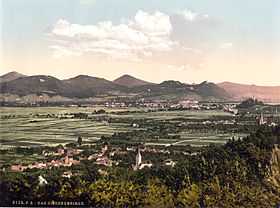Siebengebirge
From Wikipedia, the free encyclopedia
| Siebengebirge | |
|---|---|
 Siebengebirge, 1900 | |
| Highest point | |
| Peak | Großer Ölberg |
| Elevation | 460 m (1,510 ft) |
| Coordinates | 50°40′46″N 07°14′54″E / 50.67944°N 7.24833°ECoordinates: 50°40′46″N 07°14′54″E / 50.67944°N 7.24833°E |
| Geography | |
<div style="padding:2px 2px 5px 2px;> | |
| Country | Germany |
| Geology | |
| Orogeny | Volcanic |
| Period | Oligocene |

The castle Schloss Drachenburg is one of the landmarks of the Siebengebirge
The Siebengebirge (lit. "seven hills" in German) is a German upland range to the East of the Rhine, southeast of Bonn, consisting of more than 40 hills. It is located in the municipalities of Bad Honnef and Königswinter. It is of volcanic origin and came into being between 28 and 15 million years ago. Much of the territory covered by the Siebengebirge belongs to the Naturpark Siebengebirge, which is under environmental protection.
The highest peak is the Ölberg at 460 metres. It is a popular tourist destination for hiking, because of its natural beauty.
Hills
The seven most important hills:
- Großer Ölberg (460 m)
- Löwenburg (455 m)
- Lohrberg (435 m)
- Nonnenstromberg (335m)
- Petersberg (331 m, Former name: Stromberg)
- Wolkenburg (324 m)
- Drachenfels (321 m)
Other hills:
- Himmerich (366 m)
- Trenkeberg (430 m)
- Weilberg (297 m)
- Stenzelberg (287 m)
- Broderkonsberg (378 m)
- Mittelberg (353 m)
- Leyberg (359 m)
- Jungfernhardt (320 m)
- Geisberg (324 m)
- Schallenberg (310 m)
- Großer Breiberg (313 m)
- Kleiner Breiberg (288 m)
- Wasserfall (338 m)
- Kleiner Ölberg (332 m)
- Limperichsberg
- Scharfenberg
- Zickelburg (182 m)
Origin of the name
The origin of the name Siebengebirge is disputed. Four theories exist:
- The word sieben is derived from the word siefen, which denotes the wet valley of a stream.
- The oldest name (Moller, 1590) was not Siebengebirge, but Sieben Berge (septem montes, seven hills). Depending on the viewpoint near the river Rhine, one notices almost exactly seven hills, which are not always the same and not even the highest. Also, the number seven used to denote an arbitrary amount of items, was connected to magic and thus had a highly symbolic meaning. This makes it an obvious name for an area that was said to be sinister and impenetrable before the 19th century.
- The name Siebengebirge emerged from the word Siedengebirge which indicated the presence of soap boilers ("Seifensieder"), who were banned from the valleys because boiling soap smelled so bad.
- The most common, yet wrong interpretation is that the word specifies the seven major hills.
External links
- Information and pictures about the Siebengebirge
- Rhine Dragon The Seven Mountains: a virtual tour, history, old and new legends, nature
- Honnefer Bilderbogen with pictures of the Siebengebirge
| Wikimedia Commons has media related to Siebengebirge. |
This article is issued from Wikipedia. The text is available under the Creative Commons Attribution/Share Alike; additional terms may apply for the media files.
